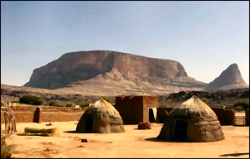
The grazing lands of the Sahel region of Africa are a vital grazing resource for the people of Africa, providing seasonal grazing for millions of animals. However, the region is subject to frequent droughts and considerable year-to-year uncertainty in availability of both fodder and surface water for cattle. Many small lakes in the region appear during the wet season but dry out during the dry season and, over millennia, human societies in the region responded to the seasonal availability of water for cattl
e by developing complex, socially-negotiated, long-distance herd-migration routes (transhumance routes) that organized and formalized access to the grazing resources of the Sahel. Since the droughts of the 1970s and 1980s the coupled hydrology and socioeconomic organization of the Sahel appears to be changing, with increasing drainage into pools that in some places now provide year-round water for cattle. The investigators hypothesize that these system level changes were triggered by the drought which reduc
ed vegetation cover & allowed increased water flows into pools. At a certain point, however, some lakes became deep enough to last through the dry season and, in some areas, the historically transhumant communities responded by settling permanently near the lakes. It may be that grazing now maintains a level of degradation and runoff in these watersheds, perpetuating the perennial lake state and permanent settlement. This project explores these complex interactions and feedbacks between climate, vegetation
dynamics, landscape hydrology, and the human societies that depend on and manage these systems.
 The grazing lands of the Sahel region of Africa are a vital grazing resource for the people of Africa, providing seasonal grazing for millions of animals. However, the region is subject to frequent droughts and considerable year-to-year uncertainty in availability of both fodder and surface water for cattle. Many small lakes in the region appear during the wet season but dry out during the dry season and, over millennia, human societies in the region responded to the seasonal availability of water for cattl
e by developing complex, socially-negotiated, long-distance herd-migration routes (transhumance routes) that organized and formalized access to the grazing resources of the Sahel. Since the droughts of the 1970s and 1980s the coupled hydrology and socioeconomic organization of the Sahel appears to be changing, with increasing drainage into pools that in some places now provide year-round water for cattle. The investigators hypothesize that these system level changes were triggered by the drought which reduc
ed vegetation cover & allowed increased water flows into pools. At a certain point, however, some lakes became deep enough to last through the dry season and, in some areas, the historically transhumant communities responded by settling permanently near the lakes. It may be that grazing now maintains a level of degradation and runoff in these watersheds, perpetuating the perennial lake state and permanent settlement. This project explores these complex interactions and feedbacks between climate, vegetation
dynamics, landscape hydrology, and the human societies that depend on and manage these systems.
The grazing lands of the Sahel region of Africa are a vital grazing resource for the people of Africa, providing seasonal grazing for millions of animals. However, the region is subject to frequent droughts and considerable year-to-year uncertainty in availability of both fodder and surface water for cattle. Many small lakes in the region appear during the wet season but dry out during the dry season and, over millennia, human societies in the region responded to the seasonal availability of water for cattl
e by developing complex, socially-negotiated, long-distance herd-migration routes (transhumance routes) that organized and formalized access to the grazing resources of the Sahel. Since the droughts of the 1970s and 1980s the coupled hydrology and socioeconomic organization of the Sahel appears to be changing, with increasing drainage into pools that in some places now provide year-round water for cattle. The investigators hypothesize that these system level changes were triggered by the drought which reduc
ed vegetation cover & allowed increased water flows into pools. At a certain point, however, some lakes became deep enough to last through the dry season and, in some areas, the historically transhumant communities responded by settling permanently near the lakes. It may be that grazing now maintains a level of degradation and runoff in these watersheds, perpetuating the perennial lake state and permanent settlement. This project explores these complex interactions and feedbacks between climate, vegetation
dynamics, landscape hydrology, and the human societies that depend on and manage these systems.






